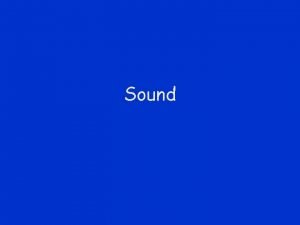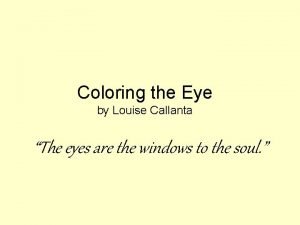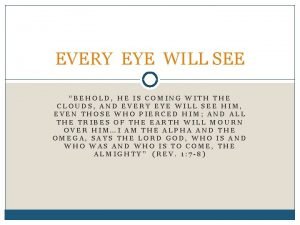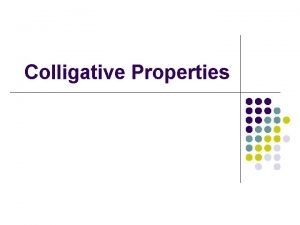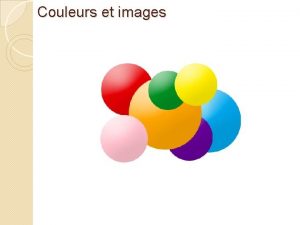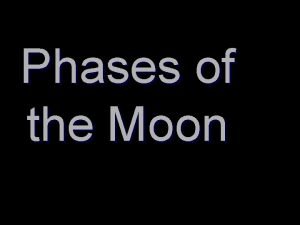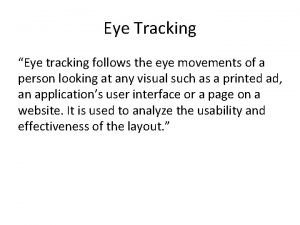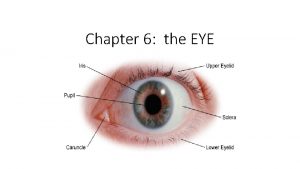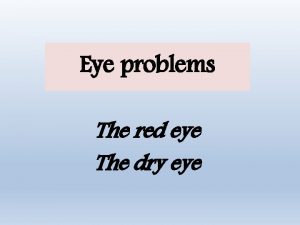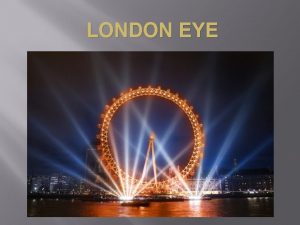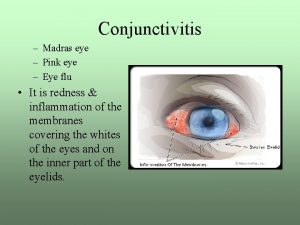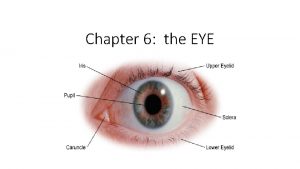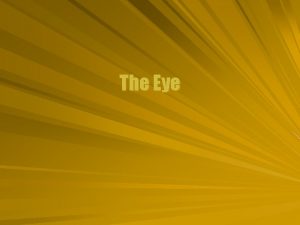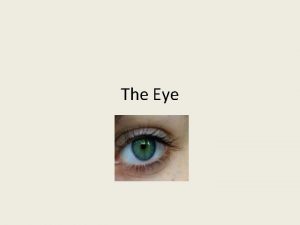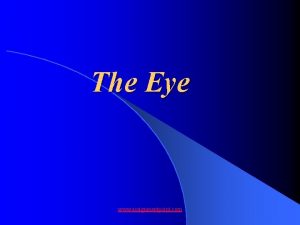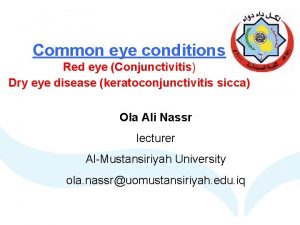Does Eye Color Depend on Gender IT MIGHT



























- Slides: 27

Does Eye Color Depend on Gender? IT MIGHT DEPEND ON WHO OR HOW YOU ASK. AMY G. FROELICH IOWA STATE UNIVERSITY JSE WEBINAR, APRIL 2014

Datasets and Stories Article �Froelich, A. G. & Stephenson, W. R. (2013) Does eye color depend on gender? It might depend on who or how you ask. Journal of Statistics Education, v. 21, n. 2. �Link to article: www. amstat. org/publications/jse/v 21 n 2/froelich_ds. pdf

Using Student Data in Introductory Statistics �Purpose: To increase student interest and obtain source of real data. �Use data set in introductory and intermediate statistics courses for data analysis and inference. �Use data set in computing course as an example of data cleaning.

The 5 Ws of the Data Set �Who: 2068 Stat 101 students �What: 15 different quantitative and categorical variables. �When: From Spring 2004 through Spring 2007 �Where: Iowa State University �Why: To motivate topics in descriptive and inferential statistics. �How: Survey through website. Student names were collected and kept separate from data. Students received a small number of homework points for completing survey.

The Variables �Gender �Age (in years) �Height (in inches) �Year in School �Eye Color �Miles from Home Town to Ames, IA �Number of Brothers �Number of Sisters

The Variables �Number of hours spent on computer per week �Exercise? (Yes or No) �Number of hours per week spent exercising �Number of music CDs owned �Number of hours per week spent playing computer games �Number of hours per week spent watching TV �Birth weight (in pounds and ounces)

Gender and Eye Color �Student reported eye color Drop down menu with 5 options � Blue, Brown, Green, Hazel, Other chosen by few students (42 out of 2068) – dropped from analysis �Gender Drop down menu with 2 options – Male, Female

Analysis of Gender Number Proportion Female 1107 0. 5464 Male 919 0. 4536 Total 2026 1. 0000 • In our data, there are more females than males. • Why?

Analysis of Eye Color Blue Brown Green Hazel Total Number Proportion 729 642 308 347 2026 0. 35982 0. 31688 0. 15202 0. 17127 1. 00000 • The proportion of students reporting blue or brown eyes are similar. • The proportion of students reporting green or hazel eyes are similar. • The proportion of students reporting blue, brown or green/hazel are similar.

Contingency Table of Eye Color and Gender Eye Color Gender Blue Brown Green Hazel Total Female 370 352 198 187 1107 Male Total 359 729 290 642 110 308 160 347 919 2026

Conditional Distribution of Eye Color Given Gender Eye Color Gender Given Female Given Male Marginal Blue Brown Green Hazel 33. 42 31. 80 17. 89 16. 89 39. 06 31. 56 11. 97 17. 41 35. 98 31. 69 15. 20 17. 13 All values are percentages.

Mosaic Plot of Conditional Distribution of Eye Color Given Gender

Findings �Brown and Hazel Similar percentages report these two eye colors from both gender. �Blue and Green Larger percentage of Males report Blue. Larger percentage of Females report Green.

Contingency Table of Eye Color and Gender Eye Color Gender Given Blue Given Brown Given Green Given Hazel Marginal Female 50. 75 54. 83 64. 29 53. 89 54. 64 Male 49. 25 45. 17 35. 71 46. 11 45. 36 All values are percentages.

Mosaic Plot of Conditional Distribution of Gender Given Eye Color

Findings �Brown and Hazel Distribution similar to overall distribution of gender. �Blue and Green Distribution tilted towards Males for Blue. Distribution tilted towards Females for Green.

Chi-square Test of Independence �

Contradictory Results �Biologically, gender and eye color are thought to be independent traits. Genetic basis for eye color not completely known. � Not simple dominant – recessive trait. Known genes for eye color not on X or Y chromosome. Genetic studies of eye color do not find dependence with gender. �In our data, reported eye color are gender were found to be dependent. Why?

Discussion of Results �Student difficulties with results. Result due to larger percentage of females in data. � Results take this difference into account. Results due to bad luck. � We obtained an unusual sample. � While possible, not probable.

Possible Explanations �

Possible Explanations �Use of student reported eye colors Genetic studies of eye color use expert opinion to classify eye colors. Differences in color perception among students related to gender?

Possible Explanations �Color Blindness – Color Vision Defect Most common is red-green color vision defects Missing one class of photopigments: medium (green) or long (red). No difficulty seeing blue (short) – vision defect appears as colors move from blue towards green and red. Difficult to distinguish between green and hazel and to distinguish between these colors and blue.

Possible Explanations �Incidence of color blindness � Approx. 8 -10% of males and less than 1% of females � Approx 73 to 92 of our 919 males students would be estimated to have a red-green color vision defect. � Due to defect, these males could be more likely to over-report blue eye color.

Possible Explanations �Distribution of true eye colors between two genders in population of Stat 101 students at ISU is different. Data collection does not allow us to draw this conclusion from this analysis. Could be unknown differences in racial or ethnic backgrounds of female and male students in Stat 101 at ISU. � Distribution of eye color varies according to racial or ethnic background.

Lesson for Students �There are no simple survey questions. What is your eye color? How many brothers/sisters do you have? �Data collection methods must match intended use. �Conclusions must take into account data collection methods.

Extensions �Gender and Eye Color Use three eye color categories: Blue, Green/Hazel, Brown Collect data in class – allows for outside corroboration of eye colors Ask students or test for color vision defects Ask students for racial or ethnic background

Extensions �Ideas for student data Social Media accounts (Facebook, Twitter, Instagram, etc. ) Cell Phone company (Verizon, AT&T, etc. ) Mobile Operating System (i. OS, Android, Windows, etc. ) Cell Phone (i. Phone, Samsung, etc. )
 Strategic gender needs and practical gender needs
Strategic gender needs and practical gender needs What does the speed of sound depend on
What does the speed of sound depend on What does the speed of sound depend on
What does the speed of sound depend on Why does a star's life expectancy depend on mass
Why does a star's life expectancy depend on mass Does morality depend on religion?
Does morality depend on religion? Two factors that affect momentum
Two factors that affect momentum Punnet square eye color
Punnet square eye color Communication with the outside world
Communication with the outside world Hammurabi
Hammurabi Bird eye view angle
Bird eye view angle Hammurabi code eye for an eye
Hammurabi code eye for an eye Pdf
Pdf Code of hammurabi activity
Code of hammurabi activity An eye for an eye a tooth for a tooth sister act
An eye for an eye a tooth for a tooth sister act Blue eyes dominant or recessive
Blue eyes dominant or recessive An eye for an eye meaning
An eye for an eye meaning Every eye is an eye
Every eye is an eye Abstracness
Abstracness Properties of l
Properties of l Physical properties of elements
Physical properties of elements Chapter 14 water supply systems
Chapter 14 water supply systems Colligative properties depend on
Colligative properties depend on Third law of thermodynamics is depend on
Third law of thermodynamics is depend on Colligative properties depend on the _____.
Colligative properties depend on the _____. Couleurs des objets
Couleurs des objets Codependency meaning
Codependency meaning Science class five
Science class five How is the moon illuminated
How is the moon illuminated


